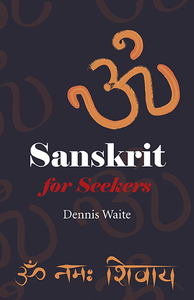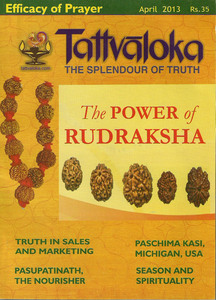Since you are reading this blog, you are presumably a spiritual seeker interested in Advaita. It is also very probable that your knowledge of Sanskrit is minimal or non-existent. I receive occasional complaints about the use of ITRANS – the transliterated ‘English’ form of Sanskrit words – so even that causes problems for many, let alone the original script (called Devanagari) which Sanskrit uses. So why would you want to learn anything at all about the language? Well, if you really are interested in Advaita (or Buddhism, if it comes to that), it is a fact of life that most of the original material from which these teachings derive was written in Sanskrit. Without any knowledge of the language, without even the ability to look up a word in a dictionary, you are forced to rely upon the abilities, and the integrity, of whichever author happened to ‘translate’ the original text on which he or she is commenting. I am currently writing a book on the Mandukya Upanishad and Gaudapada kArikA-s, and this has involved me in referencing many different translations of the original text. [Note that this is a good example why you need to know some Sanskrit. The word kArikA means ‘a verse, commentary or treatise’ but if you ignore the capitals and write this as ‘karika’, it means ‘an elephant’!] And it would amaze you how it is possible to render quite different meanings. Whether this is because of language ability or because the author has a vested interest in propagating a particular point of view is not always possible to say. What I can say, is that is essential to be able to check specific words from time to time to ensure one gleans original intent rather than a modern, possibly biased interpretation. And, before I continue, here is a confession from the introduction to the book: Continue reading
Monthly Archives: February 2014
Vedanta the Solution – Part 6
 VEDĀNTA the solution to our fundamental problem by D. Venugopal
VEDĀNTA the solution to our fundamental problem by D. Venugopal
Part 6 examines who we think we are and explains how this dictates our degree of happiness.
There is a complete Contents List, to which links are added as each new part appears.
Who Slept Well – part 2
 This is the second of a four-part article by Acharya Sadananda of Chinmaya Mission Washington (edited by myself) clarifying the nature of the deep-sleep state and addressing a number of problems which frequently cause confusion in seekers.
This is the second of a four-part article by Acharya Sadananda of Chinmaya Mission Washington (edited by myself) clarifying the nature of the deep-sleep state and addressing a number of problems which frequently cause confusion in seekers.
When I enter into a pitch dark room I cannot see the presence of any object there as it is too dark. I need a light to illumine the objects. In a pitch dark room, the existence or non-existence of any object cannot be established; they may be there or they may not. In essence, their existence becomes indeterminate or anirvachanIyam. On the other hand, I can see that the room is pitch dark and understand that it is because of this that I do not see the presence or absence of any object. Darkness envelops both the known and the unknown. However, I do not need a light to see the darkness. In addition, I know that I am there even when the room is pitch dark. I do not need a light to know that I am there. I am a self existent entity and therefore a self revealing entity, and hence I do not need any pramANa to know that I am present in the dark room. It is similar to saying that I do not need a light in order to see another light. Being a conscious-existent entity, I am also a self-revealing entity or self-luminous entity or I am aprameyam, not an object of knowledge for which a pramANa is required. In addition, my presence as a self-luminous or self-conscious entity is required to illumine any other object – tasya bhAsA sarvam idam vibhUti; it is by that light of consciousness alone that all objects get revealed. Therefore, the light of consciousness that I am can illumine the darkness as well as the light that opposes the darkness. Thus I am the light of lights, since I light the lights and darkness too – jyotir jyotiH. Therefore, I say that I see it is pitch dark which is covering the existence as well the absence of all objects. Continue reading
I – Pure Sweetness
Quote
Vicara begins with a course of uncompromising arguments within yourself to prove and affirm that you are not the body, senses or the mind, and that even when all these are changing in the course of the three states, you alone stand changeless as the background, knowing the apparent changes.
When the argument hits home, the objects drop away, one by one, until at last you stand alone in your own glory as the background. Then you cannot even say ‘I know’, because there is nothing else to be known and you stand as that knowledge, pure. This is, in short, the course of Atmavicara.
madhuryyattal anya vastu madhuri krtam akayam,
vastvantarattal maduryyam madhuri krtamayita .
[It is from sweetness that some other thing can get to be made sweet.
But sweetness in itself is not made sweet, by any other thing.]
Bhasha Pancadashi, Pancakosha-viveka, 15 (Malayalam translation)
This is a significant verse to show the self-luminosity of Atma.
By association with sweetness, any other thing becomes sweet. But sweetness by itself does not need the association of anything else in order to be sweet.
Similarly, all objects become known when they come into contact with the ‘I’. But the ‘I’ does not need the help of anything else in order to be known. It shines, by itself, even in deep sleep where no object exists. Therefore the ‘I’ is self-luminous.
Notes on Spiritual Discourses of Shri Atmananda, taken by Nitya Tripta, note 1081
Quote
To begin with I, Awareness, seem to be in the world, then the world seems to be in Me and finally the distinction between Myself and the world dissolves.
Rupert Spira from his website
Who Slept Well?
 This is the first of a four-part article by Acharya Sadananda of Chinmaya Mission Washington (edited by myself) clarifying the nature of the deep-sleep state and addressing a number of problems which frequently cause confusion in seekers.
This is the first of a four-part article by Acharya Sadananda of Chinmaya Mission Washington (edited by myself) clarifying the nature of the deep-sleep state and addressing a number of problems which frequently cause confusion in seekers.
I wish to express my appreciation to Pujya Sastriji and Shree Subbuji for directing me to the Panchadashi Ch.11, where the deep-sleep aspects are discussed extensively by Shree Vidyaranya. This article is in response to a question posed by a sincere seeker in a private mail. His question focused on the following: Who is the experiencer, knower, and the recollector of the deep-sleep state, when the mind is not there? In essence, who slept well and knows that he slept well and is now recollecting that information when he is awake. This response to the question is based on my understanding of the 11th Chapter, together with a private communication from Shree Sastriji the post to Advaitin by Shree Subbuji.
In searching for answers, I came across the article by Shree Ananda Wood on the topic of Shree Atmananda Krishna Menon’s understanding of the deep sleep state. Given the fact that all descriptions of the deep-sleep state are necessarily from the vantage point of the waking state, we can only rely for analysis on 1) shaastra pramANa and 2) those experiences that are universally common. The problems with Shree Atmanandaji’s interpretation of the deep–sleep state are noted at the end, since there are many people that I see on Facebook, as well as elsewhere, who follow Atmanandaji writings relating to deep sleep state. Continue reading
Self – Not an object of knowledge
Quote
The Sage is often loosely described as ‘one that knows
the Self’. But this is not intended to be taken in a literal sense.
It is a tentative description, intended for those that believe
ignorance to be something that exists; they are told that this
ignorance is to be got rid of by winning ‘Knowledge of the
Self’. There are two misconceptions in this. One is that the
Self is an object of knowledge. The other is that the Self is
unknown, and needs to be known. The Self being the sole
Reality, He cannot become an object of knowledge. Also being
the Self, He is never unknown. The ancient lore tells us that
He is neither known nor unknown, and the Sage confirms it.
Maha Yoga or The Upanishadic Lore in the Light of the Teachings of Bhagavan Sri Ramana, “Who”, Sri Ramanashramam, No ISBN.
upadeSha sAhasrI – part 17
Part 17 of the serialization of the presentation (compiled by R. B. Athreya from the lectures given by Swami Paramarthananda) of upadesha sAhasrI. This is the prakaraNa grantha which is agreed by most experts to have been written by Shankara himself and is an elaborate unfoldment of the essence of Advaita.
Subscribers to Advaita Vision are also offered special rates on the journal and on books published by Tattvaloka. See the full introduction
When, my dear, Atman is seen…
Quote
When, my dear, Atman is seen, heard about, reflected upon and contemplated on, all this universe becomes known. (Yajnavalkya teaching his wife Maitreyi)
Brihadaryanika Up. – 4.5.6
Review of article on Shankara by Ramakrisnan Balasubramanian
(This is a slightly modified article published here one year ago, which was improperly and incompletely posted. Ramesam had asked me to review the following article, with which I complied after much hesitation. The article is over 40 p. long and quite dense and complicated in parts – in other words, ‘academic’: for specialists only; one could add: cutting the slices so thin, that the substance is practically lost, or forgotten).
Review of ‘A New Approach to Understanding Advaita as Taught by ´Sa ˙ nkara Bhagavadp¯ada’ – by Ramakrishnan Balasubrahmanian. Continue reading


